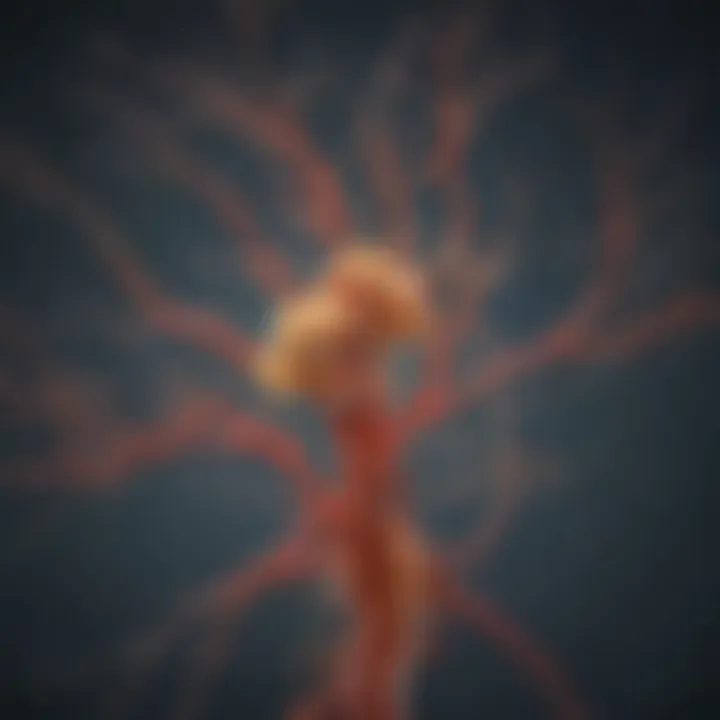POMC Neurons: Energy Homeostasis and Beyond


Intro
Pro-opiomelanocortin (POMC) neurons are a critical element in the regulation of energy balance and appetite control. Understanding their role provides insights into topics such as obesity and metabolic disorders. This article will explore the anatomy and physiology of these neurons, their signaling pathways, and how various conditions affect their functionality. The relevance of this topic extends beyond academic interest; it touches on practical implications for intervention strategies in weight management and metabolic health.
Key Findings
Major Results
- POMC neurons are located predominantly in the hypothalamus, specifically in the arcuate nucleus. They play a central role in the homeostatic control of energy expenditure and food intake.
- Activation of these neurons leads to the secretion of several peptide hormones. These include alpha-melanocyte-stimulating hormone (α-MSH) and corticotropin, both crucial in regulating appetite.
- Studies indicate that POMC neuronal activity is influenced by various metabolic signals. These include leptin, insulin, and ghrelin, highlighting their importance in energy balance.
- POMC neurons exhibit plasticity in response to dietary changes, potentially explaining adaptive behaviors in energy intake.
Discussion of Findings
The findings underscore the significance of POMC neurons in the neuroendocrine regulation of metabolism. Research shows that disruptions in POMC signaling may contribute to obesity. Such disruptions may stem from either genetic factors or environmental influences, illustrating the complexity of energy homeostasis.
Importantly, the interactions between POMC neurons and other metabolic signals suggest potential therapeutic targets. Modulating POMC signaling pathways might offer innovative approaches to treating obesity and related disorders.
As new technologies emerge, future research could focus on the dynamic behavior of POMC neurons under varying physiological states and their broader implications for health.
Methodology
Research Design
The research portfolio regarding POMC neurons encompasses various methodologies. Many studies utilize rodent models to investigate the functional aspects of these neurons. These models allow controlled experimentation for observing the effects of different dietary and hormonal manipulations on POMC activity.
Data Collection Methods
Data collection often includes techniques such as:
- Electrophysiological recordings to assess neuronal activity.
- Imaging techniques, like in vivo microscopy, to visualize POMC neurons during different metabolic states.
- Biochemical assays to measure peptide hormone levels in response to various stimuli.
These methods contribute to a comprehensive understanding of the physiology of POMC neurons and their role in energy homeostasis.
Overall, POMC neurons stand as a cornerstone in the pursuit of understanding energy regulation. This exploration not only highlights their essential roles but also opens pathways for future research and therapeutic opportunities.
Through this article, we will further dissect the impact of POMC neurons in various contexts, emphasizing their implications on both physiological and pathological states.
Intro to POMC Neurons
Understanding pro-opiomelanocortin (POMC) neurons is vital for exploring the complex mechanisms of energy homeostasis and metabolic regulation. These neurons are integral players in the body’s energy management system and have critical implications for health and disease. Through this exploration, the emphasis will be on how POMC neurons contribute to maintaining energy balance, controlling appetite, and their interactions with various physiological signals. Researchers have begun to uncover the multifaceted roles these neurons play, not only in metabolism but also in behavioral responses to stress and other factors.
Overview of POMC Neurons
POMC neurons are located primarily in the arcuate nucleus of the hypothalamus. They are a subset of neuropeptide Y (NPY) neurons and express various neuropeptides that regulate feeding behavior and energy expenditure. The primary role of these neurons includes the production of alpha-melanocyte-stimulating hormone (α-MSH), which is known to decrease appetite and increase energy expenditure. The signaling pathway of POMC neurons provides a connection between metabolic status and behavior, demonstrating their essential role in the neuroendocrine system.
The activity of POMC neurons is influenced by external and internal cues, including hormones like leptin, which signals the body’s energy stores, and insulin, which regulates glucose levels. This intricate signaling network underscores the importance of POMC neurons in systemic homeostasis.
Historical Discoveries
The historical context surrounding the discovery of POMC neurons goes back several decades. Initial studies in the late 20th century identified the importance of POMC as a precursor protein that can be cleaved into several different peptides, including opiates and melanocyte-stimulating hormones. Researchers uncovered the role of these neurons in appetite control through animal studies, leading to the recognition of their potential in understanding eating disorders and obesity.
One of the pivotal moments in this research occurred when scientists demonstrated that genetic mutations affecting POMC expression could result in significant weight gain and metabolic dysfunction in animal models. These findings opened new avenues for research into human obesity, linking POMC signaling to critical metabolic pathways. The trajectory of research from these early discoveries has shaped our current understanding of the significant impact POMC neurons have on energy regulation and health outcomes.
"POMC neurons represent a critical link between energy balance and behavioral responses, underlying the complexity of metabolic health."
As we follow the progression of research and the unfolding revelations about POMC neurons, it becomes apparent that these neurons are not merely components of a static system. Instead, they interact dynamically with a myriad of physiological factors, influencing behavior and metabolic efficiency. Each step in this exploration reveals deeper insights into the ever-evolving landscape of metabolic research and its practical implications.
Anatomical Characteristics of POMC Neurons
Understanding the anatomical characteristics of pro-opiomelanocortin (POMC) neurons is crucial for appreciating their multifaceted roles in energy homeostasis and overall metabolic function. The precise location and structure of POMC neurons are not only significant for their functional output but also influence how they interact with other systems in the body. This section elaborates on two key aspects: the location of POMC neurons within the central nervous system and their distinct morphological features.
Location in the Central Nervous System
POMC neurons are predominantly found in specific nuclei of the hypothalamus, particularly the arcuate nucleus. This area serves as a critical integration point for various signals related to energy balance and appetite control. Located adjacent to the third ventricle, these neurons have direct access to neurotransmitters and hormones circulating in the cerebrospinal fluid.
The positioning of POMC neurons is advantageous. They are responsive to peripheral signals such as leptin, insulin, and ghrelin, which are vital for regulating energy intake and expenditure. The arcuate nucleus's connection with other hypothalamic nuclei and regions, like the paraventricular nucleus, allows POMC neurons to communicate with diverse pathways involved in appetite and metabolism.
Morphological Features
The morphology of POMC neurons highlights their specialized functions. These neurons typically possess a unique structure characterized by a small soma and long, branched dendrites. This design favors extensive synaptic interactions, facilitating communication with other neurons.


One distinct aspect is the presence of neuropeptides within these neurons. POMC neurons synthesize and release various peptides, including alpha-melanocyte-stimulating hormone (α-MSH) and beta-endorphin. These peptides play critical roles in energy regulation and modulation of mood and pain.
In terms of cellular architecture, research has identified that POMC neurons exhibit high levels of plasticity. This adaptability is essential for responding to changing nutritional states and stressors, thereby reinforcing their role in maintaining energy homeostasis.
POMC neurons, with their strategic location and intricate structure, are essential players in the regulation of energy balance and response to metabolic signals.
In summary, the anatomical characteristics of POMC neurons provide the foundation for their physiological functions. Their specific location in the hypothalamus and unique morphological traits allow them to interact efficiently with various metabolic signals, making them vital to understanding energy balance mechanisms.
Physiological Functions of POMC Neurons
Understanding the physiological functions of POMC neurons is crucial for comprehending their role in maintaining energy homeostasis and regulating various metabolic processes. This section sheds light on how these neurons influence energy balance, appetite control, and thermogenesis.
Role in Energy Balance
POMC neurons play a significant part in regulating energy balance within the body. Located primarily in the hypothalamus, these neurons release pro-opiomelanocortin peptides that have a direct effect on energy expenditure and food intake. By promoting satiety, POMC neurons help regulate how much energy the body consumes versus how much it uses.
When the body has an adequate energy supply, POMC neurons respond by producing hormones that signal fullness. Conversely, during energy deficiency states, such as starvation, the activity of these neurons decreases, leading to increased hunger.
Crucially, the dysregulation of POMC neuronal signaling can lead to conditions like obesity or metabolic syndrome. For example, in obesity, POMC neurons often become less responsive to signaling molecules like leptin, which normally suppress appetite. This insensitivity highlights the delicate balance these neurons maintain in the body’s energy homeostasis.
Regulation of Appetite
Appetite regulation is another vital function of POMC neurons. These neurons are sensitive to various metabolic signals, primarily leptin and ghrelin, which influence feeding behavior. When leptin levels are high, indicating sufficient energy stores, POMC neurons become more active and promote the release of melanocyte-stimulating hormones. This secretion leads to a decrease in appetite and an increase in physical activity.
On the other hand, low leptin levels activate hunger signals, promoting food intake. The balanced interaction between POMC neurons and these hormones is essential for maintaining proper appetite regulation. Failures in this system can contribute to eating disorders such as anorexia or uncontrolled obesity, demonstrating the importance of POMC neurons in behavioral and physiological responses to food.
Contributions to Thermogenesis
Beyond appetite control, POMC neurons also contribute significantly to thermogenesis. These neurons play a role in promoting heat production in adipose tissues, which can help regulate body temperature and energy expenditure. In conditions like cold exposure, POMC neurons can stimulate the production of uncoupling protein 1 (UCP1) in brown adipose tissue. This action enhances metabolic rate by transforming energy into heat rather than storing it.
In summary, POMC neurons are integral to physiological processes that maintain energy balance, regulate appetite, and facilitate thermogenesis. Their complex interactions with various hormones highlight their multifaceted roles in metabolism. Understanding these functions is essential for developing therapies to tackle metabolic disorders.
Key Takeaway: The functionality of POMC neurons is vital in ensuring equilibrium in energy homeostasis, appetite control, and thermogenic processes.
Molecular Pathways Involving POMC Neurons
POMC neurons are critical in maintaining energy homeostasis, and their molecular pathways facilitate various physiological processes related to metabolism. Understanding these pathways helps researchers to identify potential therapeutic targets for metabolic disorders. This section discusses the signaling mechanisms, interactions with other neurotransmitters, and genetic regulation that are crucial for the functioning of POMC neurons.
Signaling Mechanisms
The signaling mechanisms of POMC neurons are complex and involve various molecular pathways. These neurons primarily respond to changes in energy balance and metabolic state through signaling molecules such as leptin and insulin.
Leptin, produced by adipose tissue, activates POMC neurons, leading to the release of α-melanocyte-stimulating hormone (α-MSH). This neuropeptide plays a significant role in appetite suppression and energy expenditure. On the other hand, insulin also stimulates POMC neurons, enhancing α-MSH release, which contributes to the regulation of glucose levels and overall metabolic processes.
This signaling involves several intracellular pathways, including the phosphoinositide 3-kinase (PI3K) pathway and the signal transducer and activator of transcription (STAT) pathway. Activation of these pathways leads to changes in gene expression, modulating the functionality of POMC neurons.
Interplay with Other Neurotransmitters
POMC neurons do not function in isolation; they interact with numerous neurotransmitters, creating a network that influences various physiological responses. For instance, the interaction between POMC neurons and other neuropeptides like neuropeptide Y (NPY) and agouti-related peptide (AgRP) is essential in regulating appetite and energy balance.
When energy levels are low, NPY and AgRP are released, promoting feeding behavior and decreasing energy expenditure. Conversely, when POMC neurons are activated, they antagonize the effects of these neuropeptides, thereby supporting weight loss and increased energy utilization. These complex interactions underline the importance of POMC neurons in coordinating a balanced response to the body's metabolic needs.
Genetic Regulation
Genetic regulation plays a vital role in the functioning of POMC neurons. Variations in genes associated with POMC signaling can result in different metabolic outcomes. For example, polymorphisms in the POMC gene itself or related genes may affect the production and release of peptides like α-MSH.
Research has revealed that mutations in the POMC gene can lead to obesity, indicating that these genetic factors can substantially impact one's susceptibility to metabolic disorders. Understanding the genetic basis of POMC neuron functionality contributes to the development of potential interventions for obesity and other metabolic conditions.
"Understanding signaling mechanisms, neurotransmitter interactions, and genetic regulation is key to unraveling the complexities of POMC neurons and their role in energy homeostasis."
Overall, the molecular pathways involving POMC neurons provide a framework for understanding their essential functions in metabolism and energy balance. This knowledge is paramount in the ongoing efforts to design effective therapies for metabolic disorders.
POMC Neurons and Metabolic Disorders
Understanding the relationship between POMC neurons and metabolic disorders is crucial for comprehending various health issues associated with energy balance and appetite regulation. POMC neurons reside primarily in the arcuate nucleus of the hypothalamus, acting as a pivotal component in the central nervous system's response to nutritional status. Disturbances in POMC signaling can contribute to a range of metabolic disorders, including obesity, anorexia, and metabolic syndrome. This section aims to explore these connections, emphasizing the significance of POMC neuron function in metabolic health.
Obesity and POMC Signaling Dysfunction
Obesity is a growing global health issue characterized by excessive fat accumulation. Studies show that dysfunction in POMC signaling may play a key role in the development of this condition. POMC neurons produce several neuropeptides, including alpha-melanocyte-stimulating hormone (α-MSH), which promotes satiety. When these neurons are impaired, either due to genetic factors or external influences like diet, the regulatory mechanism for hunger can become disrupted. This disruption can lead to increased food intake and a reduced ability to sense fullness, contributing to weight gain.
- Increased appetite and weight gain are often linked to decreased activity of POMC neurons.
- In some cases, genetic mutations affecting the function of POMC can precipitate conditions such as obesity.


The understanding of how POMC signaling dysfunction contributes to obesity highlights potential therapeutic strategies that aim to enhance the activity of these neurons, offering hope for the development of effective interventions.
Anorexia and POMC Neuron Activity
Anorexia nervosa represents a stark contrast to obesity, characterized by extreme restriction of food intake and an intense fear of weight gain. POMC neurons are also implicated in the pathology of this disorder. Increased activity of these neurons may be associated with heightened satiety and a diminished appetite, contributing to the symptoms seen in anorexia. The dynamics of POMC neuron signaling in this context are complex and require further investigation.
- Research suggests that heightened activity of POMC neurons may provide a biological basis for the aversion to food.
- The interaction between these neurons and other brain circuits involved in reward and motivation may elucidate pathways that govern eating behavior in anorexia and similar eating disorders.
Metabolic Syndrome Implications
Metabolic syndrome encompasses a cluster of conditions, including obesity, hypertension, and insulin resistance. POMC neurons play a significant role in metabolic regulation, and their dysfunction can exacerbate these conditions. The connections between POMC activity and aspects like insulin sensitivity and lipid metabolism are critical to understanding the syndrome.
- POMC neurons contribute to the regulation of energy expenditure, influencing how the body processes fats and sugars.
- Disruption in POMC signaling may lead to increased risk factors for developing type 2 diabetes and cardiovascular diseases.
In summary, POMC neurons are situated at the intersection of various metabolic disorders. Recognizing their multifaceted role can facilitate the development of targeted therapies aiming to restore normal signaling pathways. As research on POMC continues, it is essential to consider both the implications of their dysfunction and the potential avenues for intervention.
Hormonal Regulation of POMC Neurons
The regulation of pro-opiomelanocortin (POMC) neurons by hormones is essential for maintaining energy homeostasis and various metabolic processes. These neurons, located in the hypothalamus, are influenced by several hormones that play key roles in appetite control and energy expenditure. Understanding these interactions provides insights into the underlying mechanisms of obesity and metabolic disorders. This section will explore the specific hormones involved in the regulation of POMC neurons, the benefits of these interactions, and their implications in health and disease.
Influence of Leptin
Leptin is a hormone predominantly produced by adipose (fat) tissue. It communicates the energy reserves of the body to the brain. High levels of leptin typically signal sufficient energy storage, which results in reduced appetite and increased energy expenditure. POMC neurons express leptin receptors, making them responsive to circulating leptin levels.
When leptin binds to its receptors on POMC neurons, it activates pathways that increase the expression of anorexigenic peptides, such as alpha-melanocyte-stimulating hormone (α-MSH). This action encourages reduced food intake and promotes weight loss. Conversely, when leptin levels drop, the activity of POMC neurons decreases, leading to increased appetite.
- Benefits of Leptin Regulation:
- Helps prevent excessive weight gain by inhibiting appetite.
- Promotes energy expenditure, aiding in maintaining a healthy body weight.
- Involved in the regulation of reproductive functions.
Insulin's Role in POMC Activity
Insulin, produced by the pancreas, plays a critical role in glucose metabolism and also influences POMC neuron activity. Insulin levels often increase in response to food intake, particularly carbohydrate consumption. Like leptin, insulin acts on POMC neurons to regulate appetite and energy balance.
Insulin signaling within POMC neurons enhances the production of anorexigenic peptides, thereby promoting satiety and reducing food intake. It also opposes the effects of hunger signals that arise from ghrelin, another significant hormone.
- Considerations for Insulin and POMC Neurons:
- Insulin resistance, commonly seen in obesity, can diminish the sensitivity of POMC neurons to insulin.
- Dysregulated insulin signaling may contribute to overeating and weight gain.
Ghrelin and Appetite Regulation
Ghrelin is often referred to as the "hunger hormone". It is produced primarily in the stomach and acts on the hypothalamus to stimulate appetite. Ghrelin has a complex interaction with POMC neurons. When ghrelin levels rise, it activates neurons that promote feeding and inhibit POMC neuron activity, resulting in increased appetite.
In contrast, when ghrelin levels decrease, the suppressing effect on POMC neurons is lifted, promoting satiety. Thus, the balance between ghrelin and POMC neuron activity plays a pivotal role in appetite regulation.
- Key Aspects of Ghrelin's Influence:
- Acts as a counter-regulatory hormone to leptin and insulin.
- High ghrelin levels trigger feeding behavior, complicating weight management efforts.
The delicate balance between hormones like leptin, insulin, and ghrelin is vital for energy homeostasis. Disruption of this balance can lead to metabolic disorders, including obesity and diabetes.
Understanding the hormonal regulation of POMC neurons is critical for developing therapeutic strategies aimed at managing obesity and related metabolic disorders. By investigating these interactions further, researchers can explore potential interventions that target these hormone-neuron pathways.
POMC Neurons in Stress and Behavior
The role of POMC neurons in stress and behavior is an area of increasing interest. Understanding how POMC neurons influence these aspects can reveal important insights into emotional and physical health. Stress can have wide-ranging effects on the brain and body. POMC neurons, which are primarily located in the arcuate nucleus, are known to be sensitive to various stressors. Their activation can lead to changes in appetite, metabolism, and behavior. The connection between stress and the functioning of POMC neurons is crucial, especially in the context of stress-related disorders.
Response to Stressors
POMC neurons respond distinctly to both acute and chronic stressors. When exposed to stress, these neurons can modify their activity. Acute stress tends to activate POMC neurons, increasing the production of their neuropeptides. This response can result in increased energy expenditure and a temporary reduction in appetite. The acute stress response is tied to the body's immediate need to react to threats. On the other hand, chronic stress can lead to dysregulation of these neurons. Under prolonged stress conditions, POMC neurons may become less sensitive to signals like leptin, which regulates appetite. This decreased sensitivity can lead to weight gain and increased fat storage.
The intricate relationship betwen stress and POMC neuron activity is complex. It is influenced by several factors, including hormonal changes during stress and various neurotransmitters that modulate POMC activity. This further emphasizes the need for detailed studies looking at how external factors might impact POMC neuron function.
Impact on Mood and Anxiety Disorders
POMC neurons also play a significant role in mood regulation. Changes in their activity can directly affect mood states and are linked to anxiety disorders. Dysregulation of POMC signaling can lead to increased anxiety-like behavior. Animal studies have shown that alterations in the activity of these neurons can influence behaviors associated with anxiety. For instance, enhanced POMC activity could lead to a more effective response to stress, while reduced activity might correlate with heightened anxiety levels.
Research also suggests that POMC neurons may be involved in the regulation of stress-induced depression. Stressful experiences can result in long-term changes in how these neurons operate. Understanding the connection between POMC neurons and various mood disorders could lead to potential therapeutic strategies. Targeting this pathway may help in developing new treatments for mood and anxiety disorders, potentially improving quality of life for many patients.
"Targeting POMC signaling pathways provides a promising avenue for exploring therapeutic options for stress-induced disorders."


The implications of POMC neurons on stress and behavior are clear. Their involvement in appetite regulation and energy balance cannot be separated from their roles in stress responses and mood regulation. Future research in this area could help in finding effective interventions for those struggling with stress-related health issues.
Research Techniques for Studying POMC Neurons
Understanding POMC neurons requires careful investigation through various research techniques. These methods offer insights into the structure and function of POMC neurons, which play a vital role in energy balance and metabolism. By using these techniques, researchers can delve into the intricate workings of these neurons, elucidating their importance in health and disease. In this section, we will explore three key approaches that are critical in studying POMC neurons: genetic manipulation, imaging technologies, and electrophysiology methods.
Genetic Manipulation Approaches
Genetic manipulation techniques are fundamental in understanding the role of POMC neurons. These methods allow scientists to create specific changes to the genes involved in POMC signaling. By knocking out or overexpressing particular genes, researchers can observe alterations in neuronal function, behavior, and physiological responses.
- CRISPR-Cas9: This innovative technique enables precise editing of the genome. It allows for targeted mutations that help in studying the effects of specific genes on POMC neurons.
- Transgenic Models: Mice engineered to express fluorescent markers in POMC neurons can help visualize these neurons. This can reveal their distribution and projections in the central nervous system.
- Knockout Models: Creating mice that lack specific genes related to POMC signaling helps to understand how these genes affect metabolic processes.
These genetic approaches facilitate a deeper understanding of the molecular pathways in POMC neurons, allowing researchers to connect genetic variations to metabolic disorders.
Imaging Technologies and POMC Research
Imaging technologies provide a window into the dynamic activities of POMC neurons. These techniques enable real-time observation of neuronal activity and interactions with other brain areas.
- In Vivo Imaging: Functional imaging techniques such as fMRI and PET scanning allow researchers to study POMC neuron activity in live animals. This non-invasive approach provides insights into how these neurons respond to various stimuli, such as food intake or stress.
- Fluorescence Microscopy: This allows for detailed visualization of individual POMC neurons and their synaptic connections. High-resolution imaging techniques can track changes in neuronal morphology or calcium signaling during specific tasks.
- Optogenetics: By using light to control genetically modified neurons, scientists can activate or silence POMC neurons selectively. This approach helps to establish causal relationships between POMC neuron activity and changes in appetite or energy expenditure.
Imaging techniques are vital for understanding the functional roles of POMC neurons, revealing their importance in energy homeostasis and behaviors related to feeding.
Electrophysiology Methods
Electrophysiological techniques are essential in studying the electrophysiological properties of POMC neurons. These methods assess how neurons communicate and contribute to regulatory circuits in the brain.
- Patch-Clamp Technique: This allows for measuring ionic currents across neuronal membranes, providing insights into the excitability of POMC neurons. It helps to determine how synaptic inputs influence their firing rates.
- Multi-Electrode Arrays: These devices can measure the activity of multiple neurons simultaneously. They help to analyze how POMC neurons interact with other neuronal populations.
- Calcium Imaging: This method is used to assess calcium signaling in POMC neurons, which is crucial for understanding their activation and synaptic responses.
Through these electrophysiological methods, researchers can gain insights into the intricate dynamics of POMC neurons, revealing their roles in energy regulation and appetite control.
A thorough understanding of the research techniques used to study POMC neurons equips researchers with the tools to unravel the complexities of these critical neuronal populations.
Therapeutic Targeting of POMC Pathways
The targeting of POMC pathways for therapeutic purposes is a promising avenue in the realms of metabolic disorders and obesity treatment. POMC neurons play a pivotal role in energy expenditure and appetite regulation. Understanding and manipulating the processes these neurons undergo can lead to significant advancements in managing various health conditions, particularly those related to obesity.
The therapeutic implications of POMC pathways are multifaceted. Since these neurons directly influence hunger and energy use, pharmacological interventions can adjust signaling at different stages. These strategies could potentially normalize aberrations seen in metabolic syndromes. Moreover, the benefits encompass more than just weight loss, as they can also enhance overall metabolic health. By stabilizing POMC signaling, individuals may experience improvements in insulin sensitivity and reductions in inflammation throughout the body.
However, certain considerations must be evaluated when exploring therapeutic options targeting these pathways. Off-target effects could arise, as POMC signaling interacts with various other neuroendocrine systems. Clarity regarding optimal dosages and potential side effects is essential for any pharmacological treatment. Additionally, the long-term effects of modifying POMC activity must be researched to ensure patient safety and efficacy.
Pharmacological Approaches
Pharmacological strategies targeting POMC pathways have gained attention for their potential to prevent and treat obesity. Medications designed to enhance the signaling capacity of POMC neurons can lead to reduced food intake and increased energy expenditure. One exciting area is the development of drugs that mimic or enhance leptin's effects. Leptin is a hormone that binds to receptors on POMC neurons, promoting appetite suppression. Agents that can sustain this signaling pathway could revolutionize obesity treatment.
Another approach involves antagonizing pathways that contribute to weight gain. Ghrelin, a hormone known to stimulate appetite, antagonists might mitigate its effect on appetite when administered alongside POMC modulators.
In addition, there is growing interest in the use of combination therapies. These therapies would utilize agents acting on POMC alongside other weight management medications. By applying a multi-faceted approach, researchers hope to achieve more sustainable weight loss outcomes, avoiding the pitfalls associated with single-drug strategies.
Potential for Gene Therapy
Gene therapy represents a cutting-edge approach to alter POMC function at a fundamental level. As a technique, it provides the possibilities to directly modify or replace genes that regulate POMC neuronal function. This method is particularly appealing for individuals with specific genetic mutations affecting their POMC signaling.
Utilizing viral vectors, scientists can deliver corrective genes to target neurons, restoring normal POMC activity. This direct intervention may prove more effective than traditional pharmaceuticals since it addresses the root cause rather than the symptoms.
Moreover, advancements in CRISPR technology offer new possibilities to edit genes involved in the POMC pathway. Researchers can deactivate genes that inhibit POMC function or activate those that enhance it. This capability allows for precise tailoring of treatments based on individual patient needs. However, ethical considerations and long-term safety remain significant concerns for gene therapy in humans, necessitating rigorous evaluation in clinical trials.
Future Directions in POMC Research
Research surrounding pro-opiomelanocortin (POMC) neurons continuously evolves, shifting focus to future directions that promise enhanced understanding of their roles within energy homeostasis and other physiological processes. This section delineates the pertinent advancements and ongoing inquiries in the field, emphasizing their potential implications for health and disease management.
Emerging Technologies
The landscape of research technology creates new avenues for studying POMC neurons. Novel imaging techniques, for example, provide insights into the dynamic behavior and functional states of these neurons in real-time.
- Optogenetics: This method employs light to control neurons that have been genetically modified to express light-sensitive ion channels. By selectively activating or inhibiting POMC neurons, researchers can elucidate their precise role in regulating appetite and energy metabolism.
- CRISPR-Cas9 Gene Editing: This revolutionary tool allows scientists to make specific alterations to the genome. It can be utilized to investigate the genetic underpinnings of POMC signaling pathways, providing a clearer picture of how genetic factors contribute to metabolic diseases.
- Advanced Imaging Techniques: Technologies such as two-photon microscopy enable high-resolution visualization of POMC neurons in live tissue, bridging the gap between structure and function.
As these techniques develop, they hold the potential to unravel the complex interactions of POMC neurons with other neurobiological systems, leading to more targeted therapeutic approaches.
Broader Implications for Health
The implications of advancing POMC research extend far into the realm of public health and medicine. Understanding the nuances of POMC neuron activity could transform current approaches to treating metabolic disorders and obesity.
- Personalized Medicine: Insights gained may inform personalized treatment plans that consider individual genetic differences in POMC signaling. This could enhance treatment effectiveness for various metabolic conditions.
- Preventive Strategies: Identifying early biomarkers of POMC dysfunction could lead to innovative preventive measures against obesity and related diseases, enabling interventions before metabolic syndromes develop.
- Mental Health Connections: As research reveals more about how POMC neurons interact with mood regulation and stress response, it can inform holistic approaches to mental health treatments.
"The exploration of POMC neurons not only broadens the understanding of energy homeostasis but also opens new doors to address pressing health challenges."
In summary, the direction of future POMC research promises a more holistic understanding of metabolic health, impacting systemic well-being across diverse demographics. By harnessing emerging technologies and focusing on broader health implications, this field can lead to groundbreaking discoveries, potentially altering health outcomes globally.



